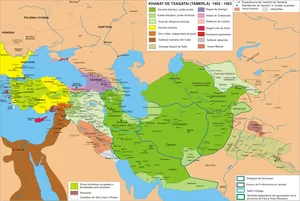Introduction: Tamerlane Invasions Impact
Tamerlane, also known as Timur, was a 14th-century conqueror whose military campaigns resulted in significant territorial expansion and profound changes across Central Asia, Persia, the Middle East, and the Indian subcontinent. While Tamerlane is often remembered for his brutal conquests and the devastation he wrought, his invasions also initiated cultural and political transformations that shaped the regions for centuries. This article explores the complex legacy of Tamerlane’s raids, examining both the destruction they caused and the societal changes that emerged in their wake.

The Timurid Conquests
Overview of Tamerlane’s Military Campaigns
Tamerlane’s military campaigns began in the late 1370s and continued until his death in 1405. He was a master strategist, often employing psychological warfare and innovative tactics to achieve swift victories against numerically superior forces. His conquests included:
- Central Asia: Establishing dominance over the Chagatai Khanate and conquering key cities such as Samarkand and Bukhara.
- Persia: Invading and decimating regions in modern-day Iran, particularly during campaigns against the Jalayirid and Muzaffarid dynasties.
- The Indian Subcontinent: His notorious sack of Delhi in 1398 left the city in ruins and significantly weakened the Delhi Sultanate.
- The Caucasus: Repeated invasions of Georgia and Azerbaijan caused immense suffering and disruption.
Destruction and Suffering
Tamerlane’s invasions were marked by extreme violence. The capture of cities often resulted in mass slaughter, enslavement, and destruction of infrastructure. For example:
- Sack of Delhi (1398): Tamerlane’s forces killed hundreds of thousands, destroyed temples, and plundered wealth, leading to a dramatic decline in the city’s status.
- Siege of Isfahan (1387): After the city resisted, Tamerlane ordered the execution of a significant portion of the population, and the city was left in ruins.
These campaigns not only devastated local economies but also left deep psychological scars on the survivors, impacting the social fabric of affected societies for generations.
Cultural Impact and the Timurid Renaissance
Despite the destruction, Tamerlane’s rule also fostered a cultural revival, known as the Timurid Renaissance. This period was characterized by significant advancements in various fields, including:
Architectural Developments
Tamerlane invested heavily in architecture, leading to the construction of monumental structures. Key examples include:
- Registan Square in Samarkand: A stunning example of Islamic architecture featuring intricate tile work and grand madrasahs.
- Shah-i-Zinda: A necropolis in Samarkand that showcases elaborate mausoleums and vibrant mosaics.
Artistic Flourishing
The influx of artists, scholars, and craftsmen from various regions transformed the cultural landscape. Persian literature and miniature painting thrived, and the blending of various artistic traditions enriched the cultural heritage of the empire.
Scientific Advancements
The Timurid courts became centers of learning, promoting advancements in mathematics, astronomy, and medicine. Scholars such as Ulugh Beg, Tamerlane’s grandson, made significant contributions to astronomy, including the establishment of observatories.
Societal Changes and Power Dynamics
Shifts in Political Power
Tamerlane’s conquests disrupted existing political structures, leading to the rise and fall of various dynasties. Traditional rulers were often replaced or forced into vassalage, as Tamerlane installed puppet leaders to maintain control over newly conquered territories.
- Delhi Sultanate: The imposition of Tamerlane’s authority marked the beginning of the decline of the Sultanate, paving the way for future Mughal rule.
- Golden Horde: Tamerlane’s victories over the Golden Horde significantly weakened its power, contributing to its fragmentation into smaller khanates.
Ethnic and Religious Changes
The invasions also had profound effects on the demographic and religious landscapes of the conquered areas:
- Cultural Intermixing: The movement of populations and the establishment of trade routes facilitated cultural exchanges, resulting in a unique blend of Persian, Turkic, and Indian influences.
- Religious Tensions: Tamerlane’s campaigns often exacerbated sectarian tensions, particularly in Persia and India, where his forces clashed with local Hindu and Christian populations.
Legacy of Gunpowder Empires
The military innovations and administrative practices developed during Tamerlane’s reign laid the groundwork for the emergence of the Gunpowder Empires in the 16th century, including:
- The Ottoman Empire: Building on Tamerlane’s military tactics and territorial ambitions, the Ottomans would rise to become a dominant power in both Europe and Asia.
- The Mughal Empire: Founded by Babur, a descendant of Tamerlane, the Mughal Empire drew on the cultural and administrative legacies of its Timurid predecessor.
Conclusion
Tamerlane’s invasions were a pivotal moment in world history, leaving a legacy that was both destructive and transformative. While his campaigns caused immense suffering and destruction, they also initiated a cultural revival that enriched the regions he conquered. The shifts in power dynamics, the rise of new empires, and the lasting impacts on art, architecture, and science illustrate the complex and dual nature of Tamerlane’s legacy. Understanding these effects provides valuable insights into the historical narratives of Central Asia, Persia, and the Indian subcontinent, as well as the broader dynamics of conquest and cultural exchange throughout history.
📚 Take Your Trading And Financial Skills to the Next Level!
If you enjoyed this post, dive deeper with our Profitable Trader Series—a step-by-step guide to mastering the stock market.
- Stock Market 101: Profits with Candlesticks
- Stock Market 201: Profits with Chart Patterns
- Stock Market 301: Advanced Trade Sheets
Start your journey now!
👉 Explore the Series Here
For Regular News and Updates Follow – Sentinel eGazette